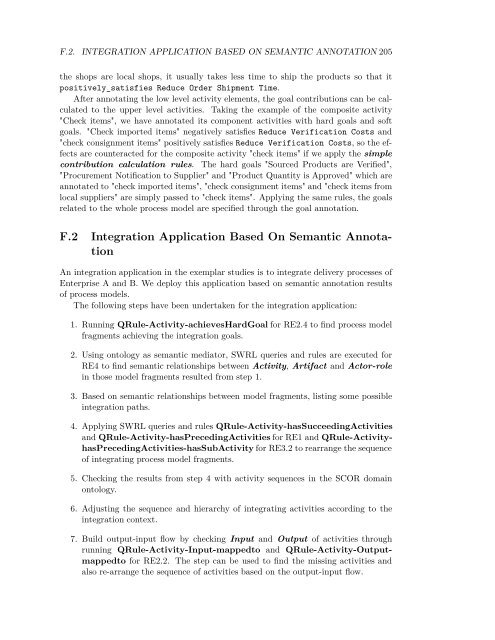Semantic Annotation for Process Models: - Department of Computer ...
Semantic Annotation for Process Models: - Department of Computer ...
Semantic Annotation for Process Models: - Department of Computer ...
Create successful ePaper yourself
Turn your PDF publications into a flip-book with our unique Google optimized e-Paper software.
F.2. INTEGRATION APPLICATION BASED ON SEMANTIC ANNOTATION 205<br />
the shops are local shops, it usually takes less time to ship the products so that it<br />
positively_satisfies Reduce Order Shipment Time.<br />
After annotating the low level activity elements, the goal contributions can be calculated<br />
to the upper level activities. Taking the example <strong>of</strong> the composite activity<br />
"Check items", we have annotated its component activities with hard goals and s<strong>of</strong>t<br />
goals. "Check imported items" negatively satisfies Reduce Verification Costs and<br />
"check consignment items" positively satisfies Reduce Verification Costs, so the effects<br />
are counteracted <strong>for</strong> the composite activity "check items" if we apply the simple<br />
contribution calculation rules. The hard goals "Sourced Products are Verified",<br />
"Procurement Notification to Supplier" and "Product Quantity is Approved" which are<br />
annotated to "check imported items", "check consignment items" and "check items from<br />
local suppliers" are simply passed to "check items". Applying the same rules, the goals<br />
related to the whole process model are specified through the goal annotation.<br />
F.2 Integration Application Based On <strong>Semantic</strong> <strong>Annotation</strong><br />
An integration application in the exemplar studies is to integrate delivery processes <strong>of</strong><br />
Enterprise A and B. We deploy this application based on semantic annotation results<br />
<strong>of</strong> process models.<br />
The following steps have been undertaken <strong>for</strong> the integration application:<br />
1. Running QRule-Activity-achievesHardGoal <strong>for</strong> RE2.4 to find process model<br />
fragments achieving the integration goals.<br />
2. Using ontology as semantic mediator, SWRL queries and rules are executed <strong>for</strong><br />
RE4 to find semantic relationships between Activity, Artifact and Actor-role<br />
in those model fragments resulted from step 1.<br />
3. Based on semantic relationships between model fragments, listing some possible<br />
integration paths.<br />
4. Applying SWRL queries and rules QRule-Activity-hasSucceedingActivities<br />
and QRule-Activity-hasPrecedingActivities <strong>for</strong> RE1 and QRule-ActivityhasPrecedingActivities-hasSubActivity<br />
<strong>for</strong> RE3.2 to rearrange the sequence<br />
<strong>of</strong> integrating process model fragments.<br />
5. Checking the results from step 4 with activity sequences in the SCOR domain<br />
ontology.<br />
6. Adjusting the sequence and hierarchy <strong>of</strong> integrating activities according to the<br />
integration context.<br />
7. Build output-input flow by checking Input and Output <strong>of</strong> activities through<br />
running QRule-Activity-Input-mappedto and QRule-Activity-Outputmappedto<br />
<strong>for</strong> RE2.2. The step can be used to find the missing activities and<br />
also re-arrange the sequence <strong>of</strong> activities based on the output-input flow.
















